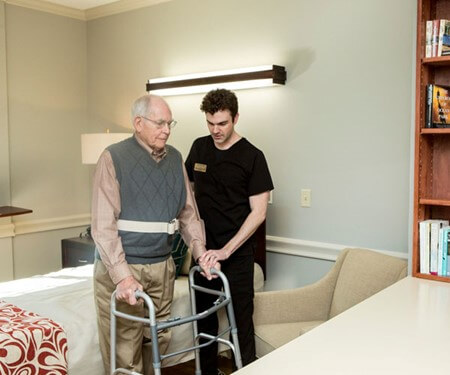
When an older adult comes to our Rehab-to-Home Center for short term rehabilitation following a hospital stay for an illness, surgery or accident, at Blakeford we make it our duty to provide compassionate and personalized care to return the patient to their previous level of functioning and wellness as quickly as possible.
While a lot of attention in the rehabilitation process focuses on progress made at the rehabilitation facility, one of the most overlooked steps in the rehab process is the adult’s transition from rehabilitation center to back home. This difficult step can often be a slow and frustrating process for the patient as they re-acclimate themselves to home life.
If you or a loved one are soon to transition home after a rehabilitation stay, keep these suggestions in mind to assure for a smooth transition.
5 Tips for Transitioning Back Home After Rehab
When the time comes to transition from short-term rehabilitation to back home, follow these tips for continued recovery.
Make a Plan & Set Goals With Your Rehab Team
Continuing with your recovery alone at home can be an intimidating thought. Before returning home, make sure to connect one last time with your therapy team to discuss their expectations for your continued recovery. Here, your physical therapists, nutritionists, and social workers can assuage your fears and anxieties of recovering at home by coming up with a personalized plan and set of goals for you to follow. By having a plan set in stone, you can continue to stay motivated and monitor your progress to make sure you’re moving in the right direction.
Make Necessary Home Accommodations
Depending on your ailments, your recovery may dictate certain changes to your home environment in order to facilitate easy movement and keep you safe from accidents and future harm. These accommodations can include things like installing support bars in the bathroom, increasing the lighting in your home, or fitting a stairlift for safe mobility in multi-level homes. Your therapists can help determine potential hazards in your home with a home safety assessment. It’s best to get these accommodations done ahead of time with the help of a loved one to make sure your home is safe for you once you’re released.
Know Your Medications
Part of the plan discussed with your therapy team before departure will be managing your medications. It’s important you understand what each of your medications does and the prescribed instructions for taking them. Setting timers and keeping a notepad by your medications is an easy way to keep track of time and know which pills you have and have not taken so far.
Keep a Positive Attitude
Recovery does not happen overnight. After being released to their home, many older adults may feel frustrated or sad over the fact that everyday tasks seem to take longer to accomplish than usual, or that they don’t see immediate improvements in their health. Maintaining a healthy mindset and keeping realistic expectations in mind is critical. Overexerting yourself or trying to rush your recovery may result in injury or delay the recovery process. Keep your head held high and know every day is a step in the right direction!
Don’t Be Afraid to Ask For Help
You may think that just because you’re out of rehab means everybody’s expecting you to be back to normal. That’s not the case. Recovery can be a long process, but you’re not expected to do it alone! There are plenty of people in your corner willing to help you out. Don’t be afraid to ask for help when you need it: from a doctor, spouse, or family member. It can be as simple as reaching out to a friend to help with errands or contacting your therapy team to ask questions about your medical care. Recovery is a group effort!
Short Term Rehabilitation Services Tailored to YOU!
At Blakeford’s Rehab-to-Home Center in Nashville, Tennessee, you receive personalized care and attention from our team of highly-qualified therapists to get you back on your feet and back home as quickly as possible. Learn more about our rehabilitation services and even schedule a tour of our facilities by contacting our senior living specialists.
Related Blog Posts:
From Home Modifications to Foot Care: Tips for Decreasing Fall Risks
